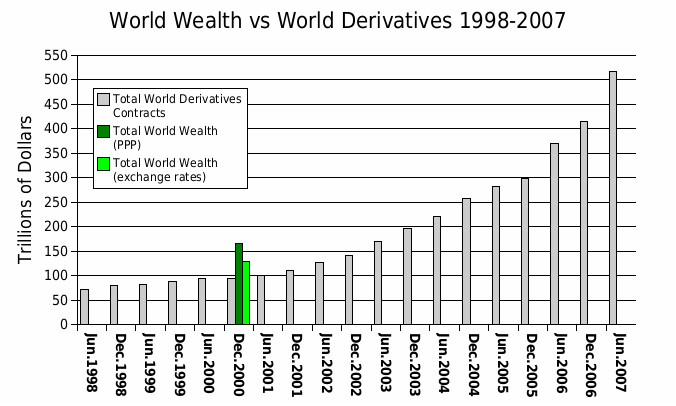To resolve the Libor scandal, we must decide. Do we want to save banks, or our societies?
August 1st, 2012
Raúl Ilargi Meijer, editor-in-chief of The Automatic Earth, wrote three weeks ago that Libor rigging was a criminal conspiracy from the start. Here he provides an update which summarizes how collusion between large banks and central banks/regulators allowed the rate-rigging scandal to continue unchecked, at the expense of society and the real economy, for decades. This is an edited version of Raúl’s piece, the emphases are mine.
In the US, the UK and European Union, the actual say a voter gets to exercise from the ballot box has been reduced to something fast approaching the freezing point. The story of Libor is an excellent example of the inner workings of this process, and of the consequences that follow …
There is no segment of private industry that has grabbed more power than the banking industry… Banks will offer up individual traders as lambs for the sacrificial chopping block, and lawmakers will declare that justice has been done. The traders can protest as much as they want that they were not operating in a vacuum, and that their superiors were very much aware of their machinations, if not outright demanding them, but it will make no difference. Bob Diamond was thrown to the wolves so Mervyn King could stay where he is. King himself made sure of it …
The underlying idea for Libor was always: “by the bankers, for the bankers”. And if anyone involved in setting up Libor back in 1985 now wishes to claim that they had no idea that allowing banks to make up the rates at which they borrowed out of thin air created scope for manipulation, that would insult everyone’s intelligence including yours and mine. The problem is that in today’s climate, this doesn’t keep them from making precisely such claims. And that is very much part of a trend. It has increasingly become acceptable for bankers and politicians alike to deny anything flat out and see what happens, knowing their friends have their backs.
I don’t know that US finance secretary Tim Geithner said it in exactly so many words, but he did at least strongly imply that he didn’t know about Libor manipulation until the spring of 2008. And he then proceeded — along with the likes of Hank Paulson and Ben Bernanke — to base the rates for the bailout programs such as Tarp, six months or so later, on that same manipulated rate, saving the banks tens of billions of dollars in the process.
Bank of England Governor Mervyn King did him one better: he stated he didn’t know anything about Libor manipulation until two weeks prior to his parliamentary hearing on July 17, despite receiving correspondence from Geithner telling him about it, over four years ago. Geithner declared he had been very clear, and even went to the unusual step of putting his warnings to King in writing. King claims he never saw any warning signs …
Some — pretty nauseating — quotes by King from that parliamentary hearing: “No-one saw it because the game wasn’t fixed”, and “There were concerns about the accuracy of Libor during the financial crisis but that is not the same as proof that the figures had been manipulated for private gain,” […] “That is my definition of fraud.”. King then accused bankers involved in Libor rigging of “fraud motivated by personal greed”. Mirror, mirror on the wall…
By the way, in November 2008 King described Libor to the UK parliament like this: “It is in many ways the rate at which banks do not lend to each other, … it is not a rate at which anyone is actually borrowing.”
Let’s be bluntly honest here, why don’t we: both Geithner and King are simply lying. And even if we can’t prove they are lying, we can certainly state that their words lack all plausibility. That is because Libor is arguably the most important number in the financial industry of the past two decades, and people who reach positions such as the ones Geithner and King hold, MUST have known for a long time what was going on with Libor.
Along the same lines that you don’t win a Nobel prize in physics if you don’t know that E = MC squared, you don’t get the world’s top jobs in overseeing banking and finance if you don’t know what and who is involved in Libor. If only because it would make you a potential threat to those profiting from it.
The reason Libor was used as the foundation for Tarp and other bailouts despite the fact that in the fall of 2008 everyone in the field knew it was rigged (well, except for Mervyn King) was not because there were no — potentially more reliable — alternatives that could have been used. No, it was the very fact that Libor was the rate that could most easily be manipulated. And was. Had been for years. The proof is there for all to see. Emails and letters are there to show this, no matter what denials are issued.
Meanwhile the timeline for who knew, or should have known, what about Libor rigging keeps being pushed back.
Whereas Mervyn King, according to his own words, was as innocent as he was ignorant until June 2012, as was Bob Diamond, and Tim Geithner found out in early 2008 (can we hear them both under oath next time, please?!), and other voices mentioned 2005, former Morgan Stanley trader Douglas Keenan wrote in the Financial Times last week (My thwarted attempts to tell of Libor shenanigans) that when he came to the bank in 1991, his colleagues, who had been there longer, found him humorously naive for not knowing that Libor was actively being rigged.
That takes us smoothly back a good part of the way to 1986, Libor’s year of birth. If and when in 1991 it had been manipulated for long enough to have Keenan’s colleagues snicker at his ignorance, it seems safe to say that it has been rigged pretty much ever since its inception.
And how could it not have been? Libor requires no real data, no real rates at which banks lend and borrow. It merely asks banks to state every working day at 11.00 am GMT at what rate they think they can borrow, for a wide range of maturities in a wide range of currencies. Ergo: anything goes. This was done on purpose. Libor was built to be rigged. And here’s what is was built for:
1986 was the time when the derivatives industry was starting to take off for real. An interest rate was needed to “guide” them. But not one that would be neutral or impartial, not if the bankers had any say in the matter. They had all the say they wanted and needed. Still, as I said, I don’t think it was a conspiracy in the sense that in 1986 anybody knew exactly how big it was all going to get (not that it matters; it’s about intent).
Derivatives “languished” for a while around the one times global GDP level. Then they came into their own and rose to ten times that or more. The industry began to clue in on the virtually limitless possibilities.

The first half of the 1990s brought us credit default swaps. They are often wrongly characterized as instruments with which to hedge investments, an innocuous and benign form of insurance. But they are really instruments to hide (gambling) losses and allow the investor/gambler to circumvent reserve requirements …
The entire mortgage investment based universe — CDOs, MBS etc — was/is based on Libor as well. Banks could go nuts, and do so all the way to the bank; not only could they insure themselves for a pittance against failure on highly leveraged wagers, through Libor they even controlled how much the insurance would cost. AIG stands out as the biggest counterparty; it insured anything under the sun.
From AIG’s point of view, it didn’t matter what it insured, or what the rates were: CDS were never supposed to be triggered. They were — and are — merely a way to hide losses. The AAA ratings that Moody’s and S&P gave them made it all even better: interest rates could be kept that much lower. All for the sake of the next, and preferably larger, wager. We know how this ended for AIG. It was given our money, so it could keep on hiding losses.
There is talk of changing Libor into a better, reality-based, standard. But the plans are being drawn up by the same people who have for years at best maintained a ‘see no evil, hear no evil’ attitude. If we want a real turnaround, we must not let the same old crowd of politicians, regulators and bankers to come within a mile of negotiations for a new standard …
The “resolution” of the Libor scandal (which will probably never be completed) will show us once again that we have a choice to make between either saving the banks or saving our economies and societies.
We can’t do both. But in all honesty, I doubt that the prospect of such a choice is real. It looks to me like the choice has long since been made by a succession of unrepresentative representatives we elected with our empty votes, and who have left us with a runaway crossover between Frankenstein and the Sorcerer’s Apprentice. I wasn’t kidding when I said the other day that if you want your vote to count, you’ll have to get out into the streets to do so.
The Libor affair is one in a series of things laid bare by the ongoing financial crisis that will inevitably, at one point or another, force us to confront the moral bankruptcy at the heart of our societies.
The original version of this piece — LIBOR, Lies and Derivatives — was published at The Automatic Earth on Monday July 30th, 2012. © 2012 Copyright Raul I Meijer – All Rights Reserved Disclaimer: The above is a matter of opinion provided for general information purposes only and is not intended as investment advice. Information and analysis above are derived from sources and utilising methods believed to be reliable, but we cannot accept responsibility for any losses you may incur as a result of this analysis. Individuals should consult with their personal financial advisors.
Short URL: https://www.ianfraser.org/?p=7736

